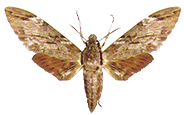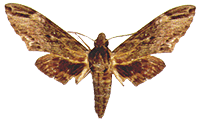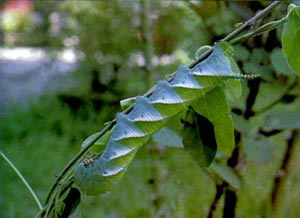|
Psilogramma menephron Cramer
Sphinx menephron Cramer, 1780, Uitl. Kapell. 3: 164.
Psilogramma menephron Cramer; Rothschild & Jordan, 1903: 42.
|

Psilogramma menephron ♂
('increta' form)
(.65
natural size)
|

Psilogramma menephron ♂
(.65
natural size) |
Diagnosis. See notes on Agrius convolvuli and Meganoton species.
Taxonomic notes. Throughout much of the range of menephron both typical
brown and ashy grey forms can be found. Both are illustrated here. The
genitalia of the two forms show no detectable differences. Diehl (1980)
referred to the grey form as P. increta Walker and noted some differences
in the larvae. The taxon increta
is typically Chinese and hence the name may not be applicable to Sundanian
grey specimens even if they should prove to be distinct from menephron.
More information is needed on the biology and larvae of the two forms
throughout the range.
Geographical range. Widespread in the Indo-Australian tropics to Vanuatu
and New Caledonia.
Habitat preference. The species is generally distributed, often common. It
may hill-top, being taken in numbers at 2600m on G. Kinabalu.
Biology. In Java (Dupont & Roepke, 1941) the larva is green or
yellowish-green with brown spots and oblique white stripes. There are
transverse rows of small conical tubercles on the thoracic and anal
segments. The horn is almost straight green with white tubercles in the
green form, and brown with yellowish tubercles in the yellowish form. Bell
& Scott (1937) show a green form where the stripes are bright green to
a central line, white below it, grading away to the pale green ground, the
white part being more or less confluent with a pale dorsal stripe: the
thorax is uniform pale green. A darker green form has brown blotches
associated with the oblique stripes in the region of the spiracles, an
extensive irregular brown area over T1 and a large brown triangle dorsally
at the posterior that terminates in the brown dorsal horn. A Hong Kong
larva is shown in Pix.

Psilogramma menephron (Sphinginade); Hong Kong
(M.J. Bascombe)
Recorded host-plants (Bell & Scott, 1937; Dupont & Roepke, 1941;
Browne, 1968; Moulds, 1981, 1984; Miyata, 1983; Bascombe, in litt.) are:
Campsis, Clytostoma, Dolichandrone, Oroxylum, Pandorea, Podranea,
Spathodea, Tecome (Bignoniaceae); Buxus (Buxaceae); Lonicera, Viburnum
(Caprifoliaceae);
Casuarina (Casuarinaceae); Pangium (Flacourtiaceae); Perilla (Labiatae);
Melia (Meliaceae); Fraxinus, Jasminum, Ligustrum, Notelaea, Nyctanthes,
Olea, Osmanthus, Syringa (Oleaceae); Sesamum (Pedaliaceae); Antirrhinum,
Paulownia, Hebe (Scrophulariaceae); Callicarpa, Clerodendrum, Gmelina,
Tectona, Vitex (Verbenaceae).
<<Back
>>Forward <<Return
to Contents page
|



